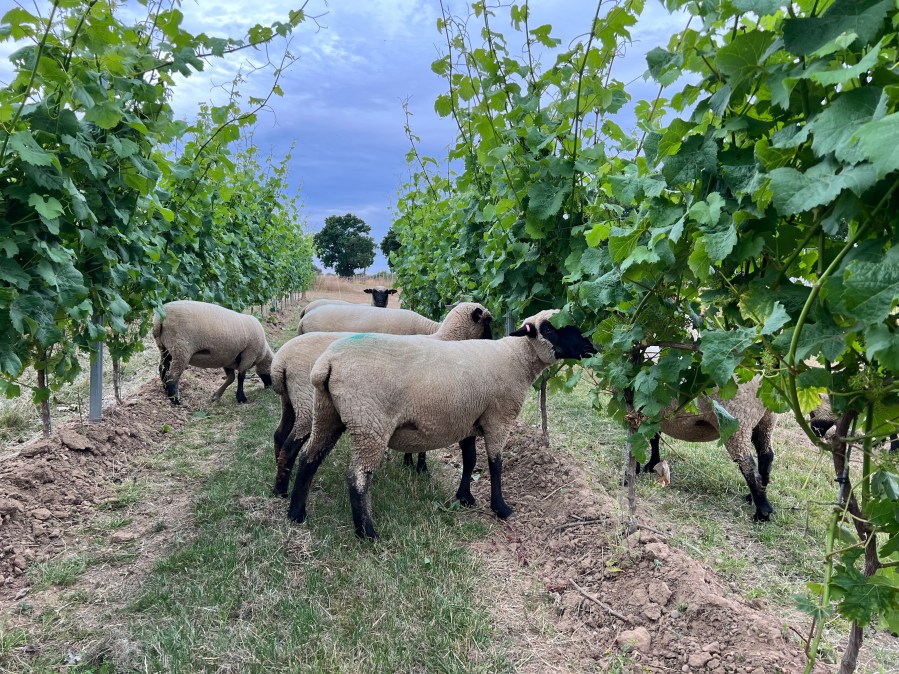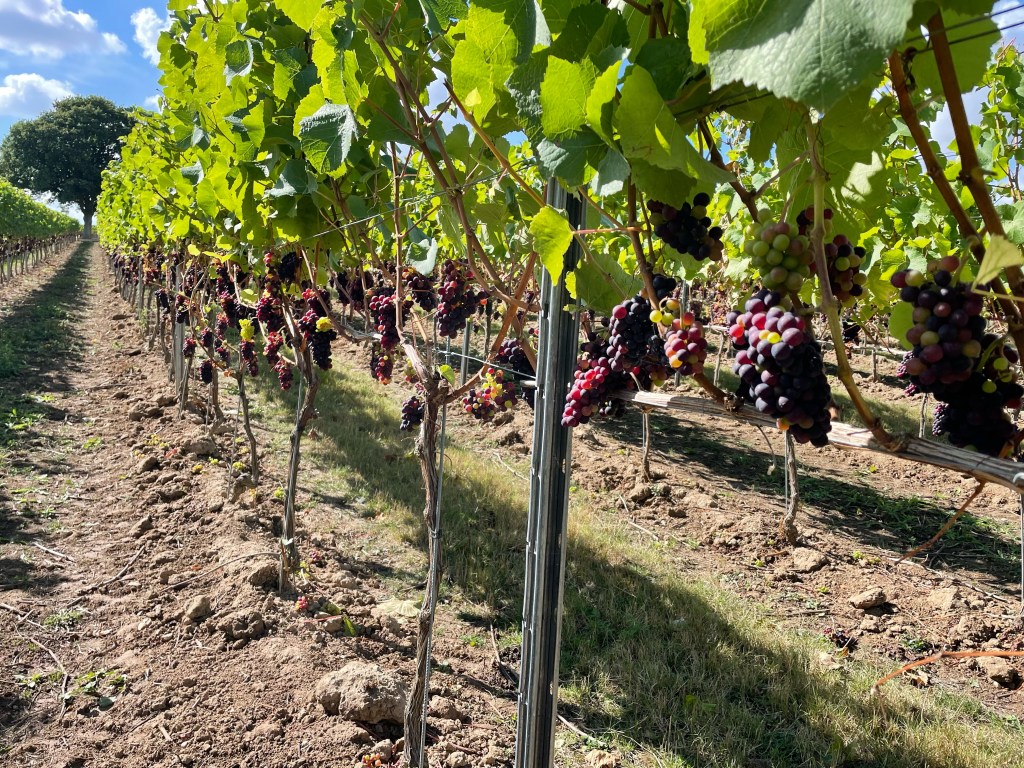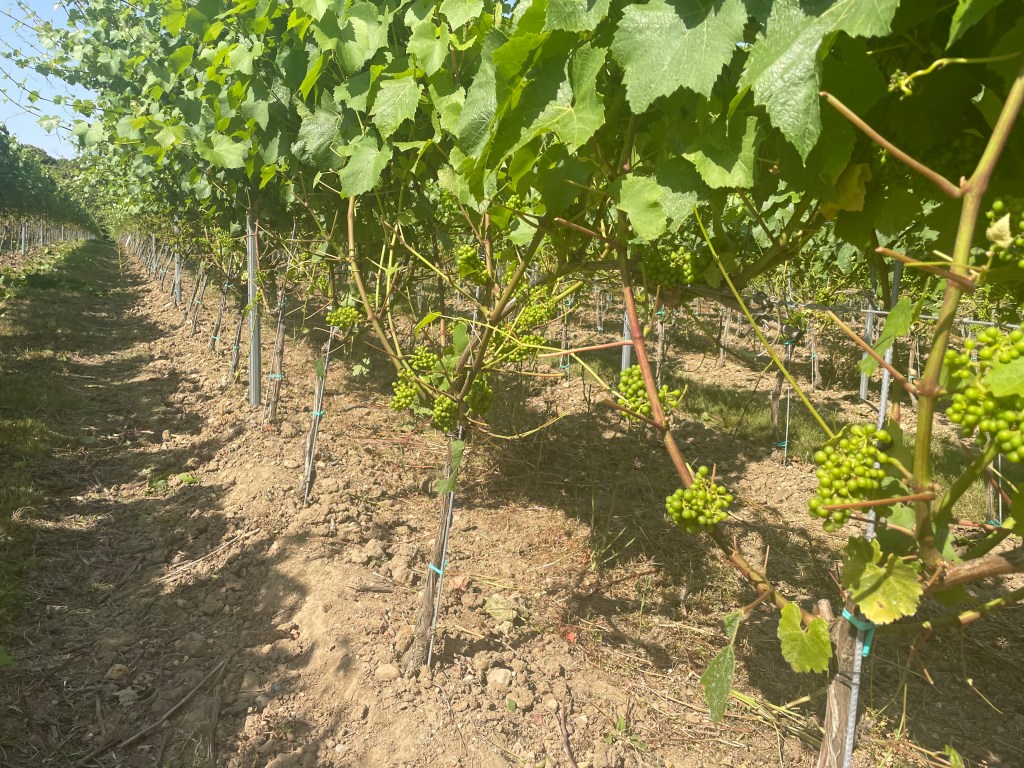Thorrington Mill vineyard, near Colchester in Essex, is using Shropshire sheep to reduce the need for mowing between the vines.
Vineyard owners Mark and Polly Baines say livestock is now an integral part of their system of sustainable wine production. The browsing sheep also replace mechanical or manual leaf removal.
“Having to mow the grass and herbage in vineyards always seems such an incredible waste of a potential resource,” said Mark Baines. “With the recent hike in fuel prices, it’s even more pressing to find a sustainable alternative.”
He said he and his wife, Polly, are committed to finding environmentally friendly ways of land management on their 65-acre family farm, bordering the Colne estuary.
Essex Saddleback pigs and Belted Galloway cattle are part of the enterprise mix, which they have created partly to enhance the quality of the rural holiday experience they offer.
The couple established a 12 acre vineyard in 2018 on the south facing slopes of their coastal farm. Varieties Pinot Noir, Chardonnay and Bacchus were chosen for their popularity and suitability for the English climate. The grape crop is generally sold to large wineries with on-site processing, such as Itasca Wines in Hampshire, although this year the Baines’s are having some of their own wine bottled and returned. They plan to build up on-farm sales of their ‘own label’ to visitors and glamping customers.
Mark also runs a landscaping and fencing business and, after the couple had invested in some specialist machinery to look after their own vineyard, they have started to provide services to other vineyard owners in the area.
Shropshire – the tree friendly breed
While the vines were getting established, Mark researched new, environmentally friendly viticulture practices and discovered Shropshire sheep. They are known for being the ‘tree friendly’ breed and are used widely by growers in northern Europe and Scandinavia, where they have a track record of grazing in conifer plantations without damaging the trees. More recently, they have come to the attention of orchard and vineyard owners. The breed is now used to graze in a range of different deciduous plantations in Britain, France and southern Europe.
Mark said: “The Shropshire breed offers a useful income stream in their own right, being reasonably prolific and with the ability to produce good quality butchers’ lambs.” Ewes are docile and easy to manage, and they thrive in a wide range of conditions. Although classed as a ‘rare breed’ in the 1970s, the Shropshire has grown in popularity in the UK over recent decades: The breed society, the Shropshire Sheep Breeders’ Association, now has around 350 members and there are flocks to be found in most regions.
Having read about the unique role the sheep could play in vineyards, Mark and Polly, decided to buy a small flock of Shropshires. They found a breeder based in Norfolk, and 12 Shropshire ewes arrived at Thorrington in 2019.
Based on the advice in the booklet Two Crops From One Acre, available from the Shropshire Sheep Breeders’ Association, they followed the brief guidelines given for managing sheep in French vineyards: “Shropshires should be introduced in the autumn about a week after grape harvest. As long as there is sufficient herbage for them, they can remain amongst the vines until spring. They must be removed as soon as the vines are budding, because the sheep will eat young leaves and this would have a detrimental effect on vine productivity.”
True to expectations, the sheep did an excellent job of clearing vineyard herbage. They ate the autumn leaves but did not touch the branches or woody stems of the vines.
Mark already had the skills needed to manage the sheep, because he had grown up on a livestock and arable farm in Essex. He points out that knowledge of routine flock management tasks is essential for anyone wishing to run Shropshires, which have the same care requirements as any other breed. You also need to have pasture available for the sheep at times when they cannot be in the vines. This will include lambing, which he and Polly schedule for late February through to early March, a quieter time of year for the couple’s other enterprises.
Serendipity at work in the vineyard
Mark and Polly discovered by accident that the Shropshires could have a much larger role in the vineyard – and one that has brought surprising benefits in terms of vine health and grape quality.
Two years ago, the sheep accidentally escaped back into the vines during the early summer – this could have been a disaster, but luckily the break-in occurred at a time when the fruit was set, but was very small and unpalatable.
“The sheep ate leaves in the ‘fruit zone’ neatly doing the job of a mechanical leaf stripper,” Mark recalls. “This is a job that is essential, and normally done either mechanically or by hand to ensure light and air can reach the fruit, giving it the best opportunity to achieve optimum yield and quality. Removing the need for mechanised leaf removal saves around
£150 – £200/acre.”
The Shropshires did no damage to the vines themselves or the fruit – and the net effect was a significant saving in labour and time, plus a healthy, abundant crop of grapes. Although Shropshires are “tree friendly”, in deciduous plantations they may eat the leaves up to about one metre from the ground. Crucially they don’t take bark off the trunks, so this leaf browsing does not damage the long-term viability of the trees. This behaviour was mirrored at Thorrington Mill, where the browse line fortunately coincided with the fruit zone.
Impressed by their accidental discovery, the Baines’s decided to repeat the process in 2021 – allowing the sheep back into the vineyard after the fruit was set, but this time as part of a supervised and closely monitored trial. They used 30 sheep in 1.5 acres at a time – allowing them five days in each area before moving them on to the next. The net effect was that around 50% of the leaves in the crucial fruit zone were removed. Again, there was no damage to the vines or the fruit.
“The results were much better than using a mechanical stripper – which can cause damage to the vines and, as growers know, this can open the door to diseases such as botrytis that can hit yield and quality,” said Mark.
“There is obviously only a relatively small window of opportunity to use sheep in this way – a few weeks before the grapes start to get larger, softer and more palatable,” Mark pointed out. “The safe period will depend on the season, of course, so the situation needs to be monitored carefully by the vineyard manager.”
Quality boost
As a result of the improved vine health and much lower levels of fungal disease, the couple noticed that the grapes could be left on the vine for much longer than usual with an amazing dividend in terms of quality.
“We were one of the last vineyards to harvest our Pinot Noir last year, with the crop coming off on November 6. The grapes were very ripe and very clean, which meant that they were good enough for red wine production in a year when some other vineyards struggled to reach the necessary quality,” said Mark.
The grapes in question were processed by Bolney Wines in Sussex and Helen Chesshire of Bolney Wine Estate commented: “Thank you so much for your amazing Pinot noir. The fruit is fantastic, and we are so pleased all your hard work has paid off in a very challenging year. This is certainly the quality level we are looking for.”
Future potential
On the strength of these results, Mark has used the sheep to partially defoliate the fruit zone in all the vines again this year, and happily the flock has increased so that he now has 100 ewes and lambs to employ on this task.
There is also scope for improving output in terms of the butchers’ lambs produced by vineyard grazing, by growing a more nutritious cover crop between the vines. Mark has been experimenting with seed mixes that include several herbal species, as well as grass. This year he is planting a three-year cover crop including red clover, fodder radish, stubble turnips and sainfoin, as well as rye grasses, cocksfoot and wildflowers such as self heal and yarrow. This will go in every-other row between the vines, alternating with grass.
Shropshire sheep have been supplied by Mark and supervised by him for use in two other local vineyards. He is working with 10 others as a contractor and he sees great potential for vineyard grazing as one of the services he offers. He plans to grow the flock numbers so that he can supply the sheep to others on a temporary basis at crucial times of year: “Some wine producers will not want the responsibility of running livestock. Although they are a docile and attractive breed, Shropshires won’t suit everyone, so a mobile service where the sheep are supplied by an experienced third party should work well and allow many more growers to get the natural benefit of using Shropshire sheep,” he stated.
What other benefits are there to running Shropshire sheep among vines? They represent a more natural way of managing vineyards and will surely become even more financially attractive as the cost of fossil fuels continues to rise and the use of agrochemicals becomes even more restricted.
Mark’s guidelines for using Shropshire sheep in vineyards
- Additional ground is needed for the sheep when not grazing in the vineyards; Additional winter forage may have to be provided if there is not enough herbage/grazing in the vineyards to feed them;
- Electric fencing is usually sufficient to retain Shropshires in the area where you want them to work, provided the power does not fail;
- Minerals should be provided at all times. In tree plantations (all species) the availability of mineral pots for sheep is considered essential, as lack of a balanced nutrient intake can sometimes lead to sheep eating the trees or nibbling the bark. Such behaviour has not been witnessed in the vines, but minerals are a sensible insurance policy;
- Water must be provided;
- Make sure you are aware of, and have time for, routine sheep management tasks such as drenching, foot trimming, shearing, controlling summer flies, monitoring and moving;
- A suitable barn may be needed for lambing, depending on the time of year that this takes place;
- Sheep can be used in the vines over winter between the end of harvest and bud burst in spring and again for a short period when fruit is set but too small and hard to be of interest to the sheep;
- Lambs can stay with their mothers (male lambs as well as females) until weaning;
- Male lambs and surplus females go to market from July/August onwards weighing 44kg plus. There is also a good demand for lamb boxes, if you have a local butcher or abattoir who provides this service;
- Shropshire sheep must be pure-bred to retain their tree and vine-safe attributes. Mark and Polly are members of the breed society, The Shropshire Sheep Breeders’ Association (SSBA), which provides a pedigree registration service to breeders, along with other useful advice such as how to avoid inbreeding and holds a couple of annual sales each year. The SSBA also has a portal on the website Sell My Livestock where registered Shropshire stock is often advertised.
- Mark and Polly Baines
- The vines later in the season
- The fruit zone after defoliation by Shropshire sheep








